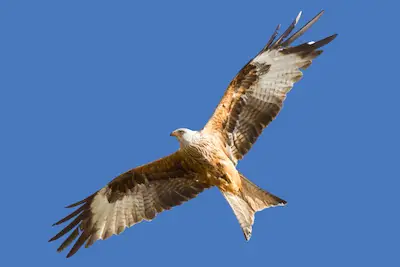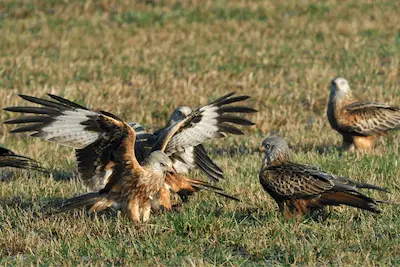Red Kite
(Milvus milvus)
The Red Kite is a large raptor that is usually encountered soaring over open landscapes, where it scours the ground for prey or carrion.

After a precipitous decline in the European population of Red Kites at the end of last century, the species has made a comeback, with many populations currently on the rise.
Among the most encouraging of these trends is the population in the UK, which was bolstered by successful reintroduction efforts in England and Scotland.
The Red Kite population in the UK is now higher than it has been for many decades, which shows that raptor conservation and reintroduction programmes are well worth the effort.
Red Kite facts
The Red Kite is most often observed soaring over open countryside, where it uses thermals to cover large distances without consuming energy, while searching for prey or carrion on the ground below.
Red Kite size
The Red Kite is a large kite species in Europe, and the wingspan of large females can approach the size of an Osprey’s wingspan.
- Red Kite wingspan: 155-180 cm
- Length: 60-65 cm
- Weight: 750-1,300 g
Based on its size and reddish coloration, this bird is relatively easy to distinguish from the Black Kite, which is smaller and darker.
Appearance
The Red Kite is a large raptor species with long wings and a long, forked tail. This, together with its reddish brown color, makes it easy to tell apart from all other European bird of prey species.

Sexual dimorphism
Similar to most birds of prey in Europe, female Red Kites are larger than males, but there is a considerable size overlap between the two genders. In other words, a small female Red Kite can be the same size as a large male.
Lifespan
A maximum age of 30 years has been recorded in the wild, as well as 38 years in captivity.
Scientific name and taxonomy
The scientific name of the Red Kite is Milvus milvus. It is monotypic (meaning there are no known subspecies). The closest relative of the Red Kite in Europe is the Black Kite (Milvus migrans), with which it can hybridize.
Red Kite distribution
The global population of Red Kites is almost entirely located within Europe, which makes it different from the other European raptors that have parts of their distribution range outside of Europe.
The Red Kite is found from the UK and Spain in the west, to Poland and Ukraine in the east. Its northernmost populations breed in the southern parts of Scandinavia. The population in the UK has grown due to successful reintroduction programs conducted in Scotland and England.
Red Kite habitat
The Red Kite prefers open landscapes with low vegetation for foraging, and in addition requires forests or small groups of large trees for nesting. Apart from this, it occurs in a wide range of landscapes, including low country as well as in hills and low altitude mountainous regions.
Red Kite population size
The population of the Red Kite in Europe is estimated to be between 19,000 and 25,000 breeding pairs by BirdLife International. However, this might be an overestimate, since there has been a significant decline in the population of Red Kites in Spain, which used to be one of the largest populations in Europe.
On the other hand, many populations of Red Kites have been increasing more recently, and hence it will require intense study and monitoring to determine the current population size of this elegant raptor species.
Red Kite behavior
The Red Kite most often searches for prey by soaring on thermal currents (which is why it often has a preference for hill country). It also hunts from a perch, and steals food from other raptors or herons (the scientific term for this is kleptoparasitism).
Feeding and diet
The Red Kite is extremely flexible in terms of what food sources it takes. It catches small animal species, including mammals, birds, reptiles, amphibians, as well as insects, and in addition to live prey it also takes carrion all year round, and is often found at roadkills.
Breeding
The Red Kite builds a large stick nest on old deciduous trees, usually at the forest edge, or within 100 meters of it. If no forests are available, it can also nest in small groups of trees in open countryside. Sometimes nests in small colonies that can also include Black Kite pairs.
The female lays 2-3 eggs, which are incubated for up to 34 days. After hatching, the young kites stay in the nest for up to 38 days, and continue to be fed up to four weeks by their parents after fledging.
Red Kite migration
The Red Kite is a partial migratory bird, with its northernmost populations being entirely migratory, while populations in central Europe are largely migratory, and populations in southern Europe are sedentary.
The migrating Red Kite populations from northern Europe winter in southern Europe. The Red Kite population in the UK is largely sedentary.
Red Kite conservation status
While the Red Kite was previously listed as “Near Threatened” by BirdLife International, due to a strong population decline at the end of the last century, the Red Kite has been reclassified as “Least Concern” more recently.
This reclassification of the conservation status of the Red Kite is due to the fact that many European populations have steadily grown over the past two decades, and this partially makes up for the previous losses.
Threats
The biggest threat to the Red Kite is habitat destruction due to changes in agricultural practices. Similar to many other European raptors that prefer open landscapes, it suffered intensely when farmland became more intensively cultivated during the last century.
However, it seems that currently the Red Kite is adapting to man made landscapes, and as a result its population has partially recovered.
Apart from habitat destruction, the biggest threat to Red Kites is poisoning from feeding on poisoned baits placed by farmers or hunters. While these poisoned baits are usually intended for other species, the Red Kite is very vulnerable to them due to its preference for carrion.
